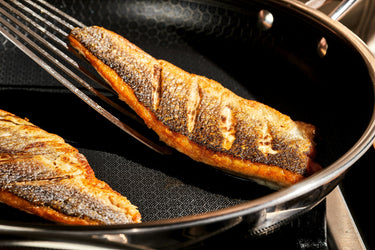8 Tips For Cooking Fish On The Stovetop

A perfectly sautéed piece of fish is a beautiful thing to behold. Sadly, it can feel like an unattainable goal for many home cooks. Fish that sticks, overcooked salmon, and that dreaded fish smell. Ugh! But, there’s no reason to be intimidated. Cooking fish on the stovetop is the best way to go for single-serving fillets (rather than a bigger piece for a crowd). With a little kitchen know-how and the right pan, you’re only a few steps away from crispy, golden skin and flaky, tender fish.
No matter what kind of fish you’re planning to cook—from salmon to cod to trout—the steps for preparing fish on the stovetop are the same, though the cooking time will vary based on the thickness of the fillets.
Here are our 8 favorite tips for cooking fish on the stovetop:
1. Start by sourcing the highest quality fish you can find.
If you’re lucky enough to live near a fishmonger that sources locally or a farmer’s market with a fresh catch stand, go there and talk to them about what they recommend. When shopping at the supermarket, check the fish counter, but don’t shy away from frozen either, since it can often be the best pick for sustainable fish. Look for an MSC-certified seal on the packaging to ensure you’re choosing a well-sourced pick. A 6- to 8-oz fillet is a good serving size for most people.
2. If you’re worried about a fishy smell, get the air moving.
To prevent a fishy smell filling up your kitchen, turn the exhaust fan to high and shut doors to any other rooms. Open a window if you have one, and be patient! The smell will dissipate soon after cooking.
3. If necessary, defrost the fish.
Once you’ve bought the fish and any sides, it’s time to cook. If you’ve started with frozen fish, first defrost the fillets. If they’re wrapped in plastic, submerge them in a bowl of cold water. They should defrost enough to cook within 30 minutes to an hour. If the fillet is wrapped in butcher paper or otherwise, defrost it on a plate or a small rimmed baking sheet in the refrigerator overnight. Defrosting the fish fully leads to a more evenly cooked final fillet. With fresh fish, you can skip straight to the next step.
4. Make sure the fish is dry.
Use a clean dishtowel (and throw it in the laundry right after) or paper towels to pat the fish dry. A dry fillet increases the chances of a proper, golden sear. Now is the time to add your favorite fish seasoning. Salt and pepper is a classic combination that pairs well with every fish. Or, add a spice mix that plays well with your side dishes. Need some ideas? We recommend sprinkling Old Bay on cod fillets and serving with potatoes. Or, mix together cumin and coriander to coat salmon fillets and serve with roasted red onions and butternut squash.
5. Next, choose the right pan.
A nonstick skillet (like HexClad’s own hybrid pans) is ideal, since it prevents the fish from sticking to the pan. For single fillets, choose a small, 8-inch skillet; for 2 fillets, use a medium, 10-inch skillet; and for 4 fillets, go with a large, 12-inch skillet. For more fillets, either cook in batches or bake the fish.
6. Time to get cooking: Heat the pan and add fat.
Heat your chosen skillet over medium-high heat. Add a small amount of oil or butter to the pan. Wait until the oil shimmers or the butter is melted.
7. Add the fillets to the pan.
Place the skin-side of the fish into the hot fat. (If you’re cooking a skinless fillet, either side works.) To avoid any splatters, start by placing one end down, then lay it down gently. Let the fish cook without moving it so the crust can form. (Do this even if you’re cooking with a skinless fillet.) After 3 to 5 minutes, check the bottom. If it’s golden brown, it’s time to flip. This is where a fish spatula—a flexible, wide, flat spatula that is slotted—comes in handy. Shimmy it under each fillet, then turn it over so the second side cooks. (Tongs work, too, but grip lightly to avoid breaking the fillets.) Cook for around 5 minutes more, or until the internal temperature reads 125ºF for medium or 145ºF for well-cooked. Of course, doneness varies based on type of fish, the thickness of the fillets, and preference, so don’t step away from the stove. You can always slide the tip of a paring knife or fork tines into the center of one piece to see if it’s done to your liking.
8. Eat it hot!
Serve the fish right away so it stays cooked to your liking. If you’re serving with a sauce or lemon wedges, add those right before eating so the skin stays crispy.
Try this stovetop cooking method with your favorite fish. It will work with tilapia, salmon, trout, bass, grouper, snapper, and Arctic char, among others.





